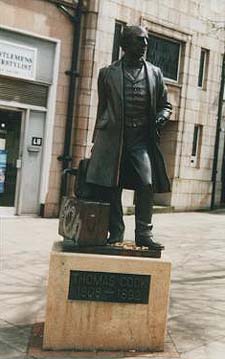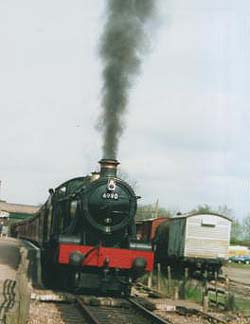Thomas Cook and the First Rail Excursion
by Diane Parkin
 It was on a summer's evening in 1841 that
a brilliant idea occurred to a foot traveller. He was on his way
to a temperance meeting in Leicester when he thought about the
railway. He realised how much time could be saved if people were
able to take trains, a recent innovation, instead of walk. At the
meeting he suggested that a special train might take him and his
fellow temperance supporters to the next quarterly meeting in
Loughborough. It was on a summer's evening in 1841 that
a brilliant idea occurred to a foot traveller. He was on his way
to a temperance meeting in Leicester when he thought about the
railway. He realised how much time could be saved if people were
able to take trains, a recent innovation, instead of walk. At the
meeting he suggested that a special train might take him and his
fellow temperance supporters to the next quarterly meeting in
Loughborough.
The man's name was Thomas Cook. He was 32 years old.
Thomas Cook used to be a Baptist preacher. Still quite religious,
he was one of many who believed that most of the social problems
of his time came down to drink. The idea was to take advantage of
this new power to help spread the message of social reform. Other
supporters at the meeting were very enthusiastic, so Cook
arranged everything with the secretary of the Midland Railway
Company.
The traveller today may still take a train from Leicester to
Loughborough, if she so wishes. When running on time, the trip
takes only around 13 minutes. It isn't only the train that will
have changed, though. Much of the landscape has been altered,
with modern roads and buildings. It is still possible to see
rabbits scampering in fields, wild primroses scrambling amid the
scrub along the railway bank, and various animals grazing.
It is worth stopping off in both towns, if you have the time, as
each has plenty to see and do. Leicester is probably the most
multi-cultural city in Britain with a huge array of museums.
Twycross Zoo and the Bosworth battlefield are both nearby.
Loughborough has a unique war memorial in Queen's Park, and the
Soar Valley and Charnwood Forest are just 'down the road' (or
track).
If you want to get a feel of how Cook's first excursion might
have felt, take a short walk from Loughborough Railway Station to
the Great Central Railway. This is a lovingly preserved steam
railway, with stations at Leicester, Rothley, Quorn &
Woodhouse, and Loughborough. Passengers may join trains at any of
these stations. There are steam and diesel engines that run at
weekends throughout the year, and on week days during the summer
months, and there are special period events throughout the year.
This wasn't built until the 1890s, so it wasn't around in Cook's
time. But the trains aren't as modern as those we are used to
seeing today.
So, it was on a summer's evening in July 1841 that the first ever
rail excursion finally took place. News soon spread and, in the
end, on 5 July, there were around 500 passengers in all, each
paying one shilling for the 12 mile return trip, travelling in
open carriages.
[Note from an alert reader: "In fact, Thomas did not organise 'the first ever railway excursion." He was beaten to it by 2 years! The world's first ever railway excursion was organised as a fund-raiser for Grosmont church and ran between Grosmont to Whitby in 1839. This is now classified as the world's first ever excursion. The statue in Leicester has now been modified to reflect this by adding an extra word!"]
 Following the success of this early passenger train
journey, Thomas Cook soon saw how profitable the idea could be on
a much grander scale. In 1845 he organised his first ever
excursion for his own profit, money clearly not something the
temperance society deemed a problem. This was a trip to
Liverpool, which was considered a very attractive town at the
time. It was the gateway to the New World, and very close to the
Welsh mountains. Following the success of this early passenger train
journey, Thomas Cook soon saw how profitable the idea could be on
a much grander scale. In 1845 he organised his first ever
excursion for his own profit, money clearly not something the
temperance society deemed a problem. This was a trip to
Liverpool, which was considered a very attractive town at the
time. It was the gateway to the New World, and very close to the
Welsh mountains.
Cook soon learned that people would travel if there was something
of interest to see, and Wales provided plenty of castles and
gorgeous scenery.
The rest, as they say, is history.
In 1863 Cook organised his first trip to Switzerland, and by the
end of the season he was responsible for more than 500 tourists
who visited the country. His circular tours covered almost every
part of the countryside there, and he was soon venturing across
the Alps into Italy.
Cook was joined in 1864 by his 30 year old son John, and by 1866
John had personally arranged his own American tour. Accommodation
negotiations followed, passengers were steaming up the Nile in
1869, and eventually Thomas Cook & Son was formed, with trips
and excursions to places as exotic and faraway as Cairo, Istanbul
(via the Orient Express), and Alexandria. When the Suez Canal was
opened, Thomas Cook embarked on his first world tour, for six
months, on 26 September 1872.
Both Cooks died during the 1890s, but the company was inherited
by John's three sons. The arrival of the aeroplane helped to make
the company one of the country's forerunners in holiday travel,
it being the world leader during the first quarter of the 1900s.
Today the traveller can go just about anywhere in the world with
them, and with space travel now on offer, who knows where next?
But it all started on a little road in 1841, when one man had an
idea.
More Information:
We regret that we no longer have the resources to maintain up-to-date links and/or hours and pricing details for the various sites and attractions listed on this website. For more information about the location(s) listed above, please use your favorite search engine or visit Wikipedia.
Diane Parkin started to write short stories for
magazines in 1985, and quit her "day job" to become a full-time
freelancer in 1996. These days she concentrates on regular
columns for Writers' News, Writing Magazine and
InteracTive, while at the same time including one-offs in
numerous national and trade magazines. Her work has appeared in
UK magazines such as Chat, My Weekly, Antiques &
Collectables, Shoot, Woman's Own, The
Lady, Bird Keeper, Country, RSPB Birds,
Family History Monthly, local county magazines and
newspapers, and on local radio.
Article and photos © 2006 Diane Parkin
|
